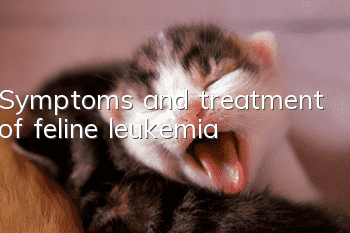Symptoms and treatment of feline leukemia

Feline leukemia is different from the leukemia we are familiar with. It is a very terrible infectious disease for cats, and high-density cat groups are more likely to be infected with this disease than cats raised individually. So how is feline leukemia transmitted? Let’s explain this issue.
FeLV is mainly infected through the mouth, but infection through the placenta may also occur; infected cats will excrete the virus through saliva, urine, feces, and milk, so close contact and mutual licking become the main modes of transmission. . Once a cat ingests the virus, the virus will multiply in the oropharynx, especially the tonsils, and then spread to other lymphoid tissues, especially the bone marrow. Many cats will launch an immune response to eliminate the virus at this stage, but the virus There may still be latent infection present in the bone marrow. Once the virus latent in the bone marrow begins to actively proliferate again, it will cause viremia and cause the virus to spread more widely, especially to lymphoid tissues and epithelial cells in the oropharynx, salivary glands, and upper respiratory tract. The virus then begins to be shed, infecting other cats. If it is at this stage, the cat's immune system may still be able to eliminate the active infection, causing viremia to last only 2 days to 8 weeks. However, some cats When the immune system is unable to eliminate this active infection, it will develop into a persistent infection, clinical symptoms will appear, and the infected cat will become the main source of infection for other cats.
The susceptibility of kittens to FeLV will decrease with age. For example, only about one-fifth of infected cats over 16 weeks of age will develop persistent infection, while the transitional antibodies in breast milk will continue to develop in the first four weeks. Protect kittens from FeLV infection.
In more than half of cats that have recovered from FeLV infection, FeLV latent infection can be found in the bone marrow. During the period of latent infection, the virus will still be shed, but the amount of virus is too low to be detected or to infect the epithelium. Cells, therefore cats in the latent infection period rarely become a source of virus transmission, and latent viruses may begin to multiply due to certain factors, such as steroid treatment. Even though latent infection usually resolves, about 10% of cats will remain latent infected for at least three years.
Symptoms of feline leukemia
FeLV-infected cats will develop relevant clinical diseases only when they develop into persistent infections. Most infected cats will die within four years. The clinical syndromes related to FeLV infection are mainly related to the infection of the hematopoietic system and bone marrow. Infection can seriously affect the development of lymphocytes and bone marrow cells, thereby causing cell proliferation (neoplasia) or inhibition. In addition, FeLV infection is often accompanied by reproductive failure.
Neoplasm
FeLV can cause tumors in lymphoid tissue or bone marrow tissue, and the most common hematopoietic malignant tumor in cats is lymphosarcoma, which accounts for about 90% of all hematopoietic system tumors and one-third of all feline neoplasia cases. Therefore, most cases of lymphosarcoma in cats are related to FeLV. Related to infection, lymphosarcoma can often be found in the kidneys, nose, eyes, central nervous system, and skin.
Anemia
Anemia is more common in cats than in other animal species, and FeLV may be the most important factor in this condition.
Immunosuppression
Persistent FeLV-infected cats are particularly susceptible to viral, bacterial, and fungal respiratory and gastrointestinal infections. Such cats usually present with weight loss and long-term poor health, or persistent fever; although Stomatitis and gingivitis in old cats are mostly related to FIV infection, but FeLV may still be accompanied by stomatitis and gingivitis; persistent abscesses or slow wound healing in young cats may also be Because of the immunosuppression caused by FeLV; there are also reports that FeLV-infected cats may develop enteritis similar to panleucopenia (cat distemper).
Reproductive disorders
FeLV infection is one of the common reproductive disorders in cats. FeLV-infected female cats usually undergo fetal reabsorption at 3 to 5 weeks of pregnancy, which may be accompanied by vaginal discharge, and most of them Infected female cats usually have had normal pregnancies before. However, the exact mechanism that causes early fetal death is not yet clear. It is generally believed that it may be related to placentitis or endometritis. Even if the fetus is lucky enough to survive to delivery, it may be small. Cats will appear persistently infected with FeLV and become weak, so FeLV may be one of the possible causes of fading kitten syndrome.
How to prevent and control feline leukemia
Since feline leukemia is highly contagious, the prevention and treatment of the disease is particularly important. Of course, if we want to prevent this disease, we must first have a certain understanding of the disease, so the first thing we have to do is to understand the cause of the disease and the corresponding symptoms, so that we can deal with it in a timely manner. After understanding this disease, let’s talk about how to prevent and control feline leukemia.
The main method of control is nothing more than regular testing and removal of positive cats. It can indeed successfully eliminate the possibility of FeLV infection in the cat population. The method is quite simple, but it may require a lot of testing costs. Generally, Breeding farms or livestock owners are deterred by this.
First, all cats will be tested, and the positive cats and negative cats will be completely isolated in different spaces. All items cannot be used interchangeably, and the environment will be inspected.Disinfect; re-test after 12 weeks, and then remove all positive cats (move to another space or euthanize); then test all cats every 6 to 12 months, and remove positive cats ; All new cats must be tested (to exclude positive cats) and quarantined for 12 weeks before being retested (to exclude positive cats).
Currently, there are many brands of inactivated vaccines available on the market, either in single-dose form or in combination with other infectious diseases (Carisi virus, herpes virus, chlamydia virus, etc.) bacteria, parvovirus, FeLV), many reports have also pointed out that vaccination with these vaccines is quite safe and can provide good protection.
It is recommended that kittens be vaccinated with the first dose of FeLV vaccine when they are nine weeks old, then vaccinated once four weeks later, and boosted once a year. Many clinical veterinarians recommend that FeLV testing be performed before vaccination because of the Vaccination does not clear previous infection, so vaccination of infected cats will not provide any benefit. This must be communicated to the owner first.
Vaccination will not cause the FeLV antigen to appear in the blood circulation, so it will not cause the ELISA test kit to be positive. Therefore, if the vaccinated cat tests positive, it means that the virus is caused by natural infection. Anemia or antigenemia is not caused by vaccination; FeLV vaccine, like most other vaccines, cannot provide 100% protection, so it cannot completely replace the "test-elimination" control method and can only be used as a FeLV Auxiliary methods for epidemic prevention.
In terms of the infection mode of FeLV, it seems that single-housed cats in the family are unlikely to be infected with FeLV. Breeding farms, pet shops, and families with multiple cats seem to have a more urgent need for vaccines. However, at present, When domestic cats often go to pet shops for grooming or boarding, vaccination is a safer way.
Vaccination cannot completely block the possibility of FeLV infection. Therefore, if a newly vaccinated cat enters the cat group without inspection and isolation procedures, it may become a source of FeLV infection.
- What does it mean if a mother cat eats a kitten?
- What's going on with the cat and the hen squatting?
- What to do if your cat’s meat pads become dry and cracked in winter
- Why do cats like to bite people? See if they have touched the cat’s restricted area?
- What is cat sucking? What does it mean to suck cats?
- Why does a cat’s coat become fluffy in winter? Does it require special care?
- How to train a Ragdoll cat? What should you pay attention to when training?
- Male cat vomits yellow water after neutering
- The cat vomited a long piece of cake
- Neutered cat vomits yellow water with foam



